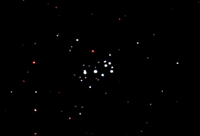Pleiades Distance - Hipparcos
Hipparcos parallaxes and the distance to the Pleiades
 |
| Pleiades animation generated using Hipparcos data. This is an 8x6 degree field. The movement of the stars over 120,000 years is shown. |
The Pleiades "distance problem" was identified shortly after the publication of the Hipparcos Catalogue in 1997, and remains unresolved. Essentially, the mean cluster distance derived from a number of individual Hipparcos parallaxes is some 10% smaller than the distance determined through main-sequence fitting. A small systematic shift of the parallaxes in this region of the sky has been proposed and cannot yet be excluded, although published explanations so far have subsequently been shown to be incorrect. A full understanding is complicated by the use of heterogeneous multi-colour photometry in different studies, and by unknown metallicity effects. The literature is extensive and complex, and is not referenced further here.
Some properties of the Hipparcos Catalogue should be recalled. Through work done during the catalogue compilation (and described in the published catalogue), and extensive studies undertaken subsequently, it is generally accepted that the quoted standard errors on the astrometric parameters are reliable estimates of their uncertainties, and that global effects in the system of positions, parallaxes, or annual proper motions are below the level of some 0.1 milliarcsec. From the intrinsic measurement process, slightly larger zonal errors on angular scales of a few degrees, of 0.2-0.3 milliarcsec, cannot be excluded, although the low star density of about 2.5 stars per square degree makes this difficult to quantify.
The 22 January 2004 Nature paper by Pan, Shao and Kulkarni, arguing that the Hipparcos data may be "contaminated by systematic errors on small angular scales", and that their results "reaffirms the fidelity of current stellar models", is a misleading contribution to a difficult and important problem. A set of optical interferometric observations of a Pleiades binary star, Atlas, is used to derive an independent but model-dependent estimate of its parallax, of 7.41 milliarcsec. The Hipparcos parallax for Atlas (HIP 17847), of 8.57+/-1.03 milliarcsec, is not mentioned by the authors, but is at roughly 1 sigma of the Pan et al result. An agreement at this level would generally be considered as fully satisfactory, providing independent confirmation that the individual Hipparcos distances are reliable, and with well-quantified standard errors. Systematic errors will exist for both programmes, and need to be discussed rigorously for both programmes. Instead, Pan et al focus on the comparison of their individual star with the Hipparcos mean distance to the cluster, and proceed to argue that the star is probably close to the cluster centre and therefore representative of the mean cluster distance (which may be so, but the authors have not demonstrated it).
In the accompanying Nature News & Views piece, Paczynski gives an informed summary of the problem, but does not address the fact that Pan et al base their conclusions on the distance to one single star. The possibility that "some residual problem with the defective orbit that has caused an unfortunate shift in the Hipparcos data" currently has no basis. USA Today picks up the story with Caltech's Kulkarni damning Hipparcos with faint praise: "We don't think this throws the whole Hipparcos mission away". Astrometrist William van Altena, of Yale University, is more reasoned: "I would say this does not cast any doubts on the Hipparcos results as a whole".
So far there has been no publication which contradicts the statistical properties of the Hipparcos Catalogue. Discrepancies have so far only surfaced when the results are compared with indirect determinations. Investigators should ensure that models on which an indirect determination is based are not themselves based on data that precedes Hipparcos by many years, or for other reasons are poorly calibrated. Are these indirect methods, indeed, demonstrably more trustworthy than the direct measurements from Hipparcos?
Confused? The Pleaides may suffer some systematic distance effect in the Hipparcos Catalogue data, and catalogue users must remain alert to the possibilites of some small zonal errors which have not yet been explained, or some deeper questions related to multi-colour photometry, metallicity or evolutionary effects. Hopefully, some future paper will resolve what Paczynski himself has described as "one of the more dramatic controversies in modern astrophysics". This Nature paper is not it.
Michael Perryman
Hipparcos Project Scientist
2004-01-29
- Removed a total of (1) align=center.
- Removed a total of (1) align=left.
- Removed a total of (1) align=right.
- Removed a total of (1) border attribute.
- Removed a total of (1) cellpadding attribute.
- Removed a total of (1) cellspacing attribute.








































 Sign in
Sign in
 Science & Technology
Science & Technology